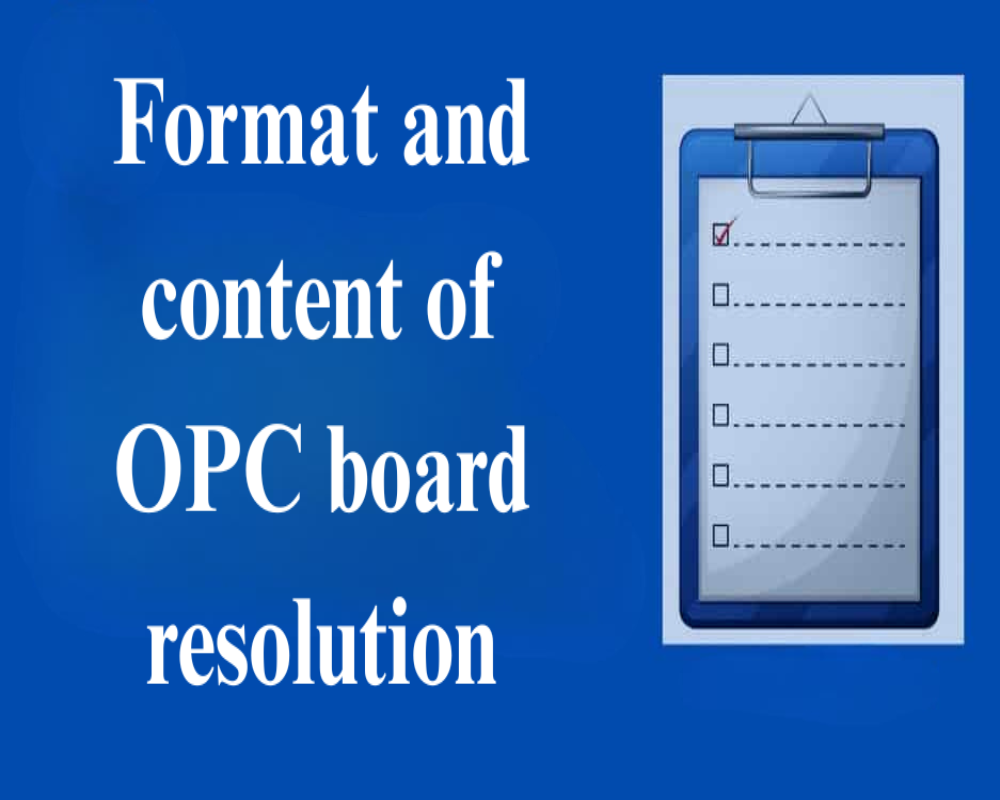Introduction
A One Person Company (OPC), despite having a single member and often a single director, is required to follow formal decision-making procedures to maintain transparency and legal compliance. One such procedure is the passing of board resolutions, which document key decisions made by the director or the board. Even though an OPC is exempt from holding physical board meetings when it has only one director, resolutions are still required for critical actions and must be recorded in writing. This article explores the format and content of board resolutions in an OPC, highlighting how they support legal governance and operational clarity.
Purpose of a Board Resolution
A board resolution serves as a formal record of decisions made by the director(s) of the OPC. It is essential for authorizing various actions such as opening a bank account, appointing an auditor, changing the registered office, or approving financial statements. For an OPC with a single director, resolutions are passed through written consent, ensuring that all major decisions are documented and legally valid.
Standard Format of an OPC Board Resolution
A typical board resolution for an OPC follows a structured format, which includes:
- Company Name
- Date of the resolution
- Title (“Board Resolution”)
- The main content or body stating the decision
- Certification of the resolution by the director
- Signature, name, and designation of the director
This standardized format ensures that the resolution is clear, professional, and legally acceptable for submission to government authorities, banks, or other stakeholders.
Heading and Company Details
At the top of the resolution, include the name of the OPC as registered with the Ministry of Corporate Affairs, along with the company’s CIN (Corporate Identity Number) and registered office address. This identifies the document as belonging to a specific entity and aligns it with other official records.
Subject Line and Title
A clear subject line such as “Resolution for Appointment of Auditor” or “Resolution for Change in Registered Office” should follow the heading. This helps quickly identify the purpose of the resolution and ensures ease of reference for future use.
Preamble and Background
The preamble provides a brief context for the resolution. It begins with “RESOLVED THAT…” and explains the action to be taken, the relevant section of the Companies Act if applicable, and the authority under which the decision is being made. For example:
“RESOLVED THAT pursuant to Section 139 of the Companies Act, 2013, M/s XYZ & Associates, Chartered Accountants, be and is hereby appointed as the Statutory Auditor of the Company…”
Decision Clause
This is the heart of the resolution. It clearly states the action approved, the name of any third party involved (like a bank or vendor), and any monetary or time-related limits. It may also include further clauses authorizing the director to carry out related activities or file forms with the Registrar of Companies.
Authorization Clause
This section authorizes a specific individual—usually the director—to sign documents, file forms, or represent the company before authorities. For instance:
“RESOLVED FURTHER THAT Mr. Ramesh Kumar, Director of the Company, be and is hereby authorized to file necessary forms with the Registrar of Companies and do all acts necessary to give effect to this resolution.”
Place, Date, and Signature
At the bottom of the resolution, include the place of passing, date, and signature of the director. It should also contain the full name, DIN (Director Identification Number), and designation of the person signing the resolution. This completes the resolution as a formal document.
Maintenance and Record-Keeping
Even though OPCs may not conduct board meetings in the conventional sense, every resolution passed must be recorded in the company’s Minute Book and maintained at the registered office. This is important for internal governance and for presenting records during audits or inspections.
Conclusion
Board resolutions in a One Person Company are essential legal instruments that formalize decisions, ensure regulatory compliance, and create an audit trail of corporate actions. While the OPC’s simplified structure reduces procedural burdens, maintaining a proper format and content in resolutions supports governance, transparency, and long-term accountability. By following a clear and standardized resolution format, OPCs can efficiently manage key decisions and maintain robust legal documentation aligned with the Companies Act, 2013.
Hashtags
#OPC #BoardResolution #CorporateGovernance #BusinessCompliance #CompanyLaw #SinglePersonCompany #LegalDocuments #BusinessStructure #ResolutionFormat #CorporateDocuments #BusinessManagement #Entrepreneurship #LegalCompliance #CompanyFormation #OPCRegulations #BusinessStrategy #DocumentPreparation #CorporateStructure #BusinessLaw #SmallBusinessTips


0 Comments